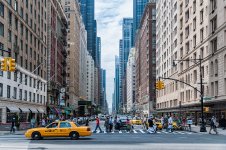Architectural photography is a captivating art form that allows photographers to capture the essence and grandeur of buildings. Whether you're a professional or an enthusiast, selecting the right lens is crucial for creating stunning architectural images. In this blog, we will explore different types of lenses and provide insights on which ones are best suited for building photography.

Wide-Angle Lens:
Wide-angle lenses are a popular choice for capturing the entirety of buildings, emphasizing their grandeur and scale. They have a focal length typically ranging from 14mm to 35mm, providing a wide field of view. Wide-angle lenses excel at capturing expansive exteriors and interiors, allowing you to include more of the building and its surroundings in the frame. They are particularly effective when photographing tall structures or confined spaces where it is challenging to step back to capture the entire building in a single shot.
Tilt-Shift Lens:
Tilt-shift lenses offer unique perspective control and are highly valued by architectural photographers. These lenses allow you to correct converging vertical lines, commonly known as the "keystone effect," which occurs when photographing tall buildings from ground level. By tilting and shifting the lens elements, you can keep the lines parallel, resulting in more accurate and visually pleasing images. Tilt-shift lenses are typically available in focal lengths ranging from 24mm to 90mm, providing versatility in capturing various architectural elements.
Prime Lenses:
Prime lenses, known for their fixed focal length, offer exceptional image quality and sharpness. They are available in different focal lengths, such as 24mm, 35mm, 50mm, and beyond, each providing distinct perspectives and angles of view. Prime lenses are particularly useful for emphasizing specific architectural details or capturing tighter compositions. While they lack the versatility of zoom lenses, their superior optics make them an excellent choice for capturing intricate elements with exceptional clarity.
Telephoto Lens:
Although not as commonly used in architectural photography, telephoto lenses can be beneficial in certain situations. With focal lengths typically exceeding 100mm, telephoto lenses compress the perspective, allowing you to isolate specific architectural details or capture distant buildings from an elevated vantage point. These lenses are useful for photographing elements like intricate ornamentation, patterns, or capturing a building from a distance when access is restricted.
Macro Lens:
While primarily designed for close-up photography, macro lenses can also be used creatively in architectural photography. Macro lenses allow you to capture intricate details of building materials, textures, or decorative elements with exceptional sharpness and magnification. They enable you to showcase the craftsmanship and finer aspects of architecture that may go unnoticed with other lenses.
Conclusion:
Choosing the right lens for building photography depends on your creative vision and the specific architectural elements you want to emphasize. Wide-angle lenses excel at capturing grand exteriors, while tilt-shift lenses correct perspective distortion. Prime lenses offer exceptional image quality and versatility, while telephoto lenses allow for unique compositions and isolated details. Lastly, macro lenses are perfect for highlighting intricate textures and details. Experimenting with different lenses will help you develop your own style and capture stunning architectural photographs that showcase the beauty and uniqueness of buildings.
Wide-Angle Lens:
Wide-angle lenses are a popular choice for capturing the entirety of buildings, emphasizing their grandeur and scale. They have a focal length typically ranging from 14mm to 35mm, providing a wide field of view. Wide-angle lenses excel at capturing expansive exteriors and interiors, allowing you to include more of the building and its surroundings in the frame. They are particularly effective when photographing tall structures or confined spaces where it is challenging to step back to capture the entire building in a single shot.
Tilt-Shift Lens:
Tilt-shift lenses offer unique perspective control and are highly valued by architectural photographers. These lenses allow you to correct converging vertical lines, commonly known as the "keystone effect," which occurs when photographing tall buildings from ground level. By tilting and shifting the lens elements, you can keep the lines parallel, resulting in more accurate and visually pleasing images. Tilt-shift lenses are typically available in focal lengths ranging from 24mm to 90mm, providing versatility in capturing various architectural elements.
Prime Lenses:
Prime lenses, known for their fixed focal length, offer exceptional image quality and sharpness. They are available in different focal lengths, such as 24mm, 35mm, 50mm, and beyond, each providing distinct perspectives and angles of view. Prime lenses are particularly useful for emphasizing specific architectural details or capturing tighter compositions. While they lack the versatility of zoom lenses, their superior optics make them an excellent choice for capturing intricate elements with exceptional clarity.
Telephoto Lens:
Although not as commonly used in architectural photography, telephoto lenses can be beneficial in certain situations. With focal lengths typically exceeding 100mm, telephoto lenses compress the perspective, allowing you to isolate specific architectural details or capture distant buildings from an elevated vantage point. These lenses are useful for photographing elements like intricate ornamentation, patterns, or capturing a building from a distance when access is restricted.
Macro Lens:
While primarily designed for close-up photography, macro lenses can also be used creatively in architectural photography. Macro lenses allow you to capture intricate details of building materials, textures, or decorative elements with exceptional sharpness and magnification. They enable you to showcase the craftsmanship and finer aspects of architecture that may go unnoticed with other lenses.
Conclusion:
Choosing the right lens for building photography depends on your creative vision and the specific architectural elements you want to emphasize. Wide-angle lenses excel at capturing grand exteriors, while tilt-shift lenses correct perspective distortion. Prime lenses offer exceptional image quality and versatility, while telephoto lenses allow for unique compositions and isolated details. Lastly, macro lenses are perfect for highlighting intricate textures and details. Experimenting with different lenses will help you develop your own style and capture stunning architectural photographs that showcase the beauty and uniqueness of buildings.
